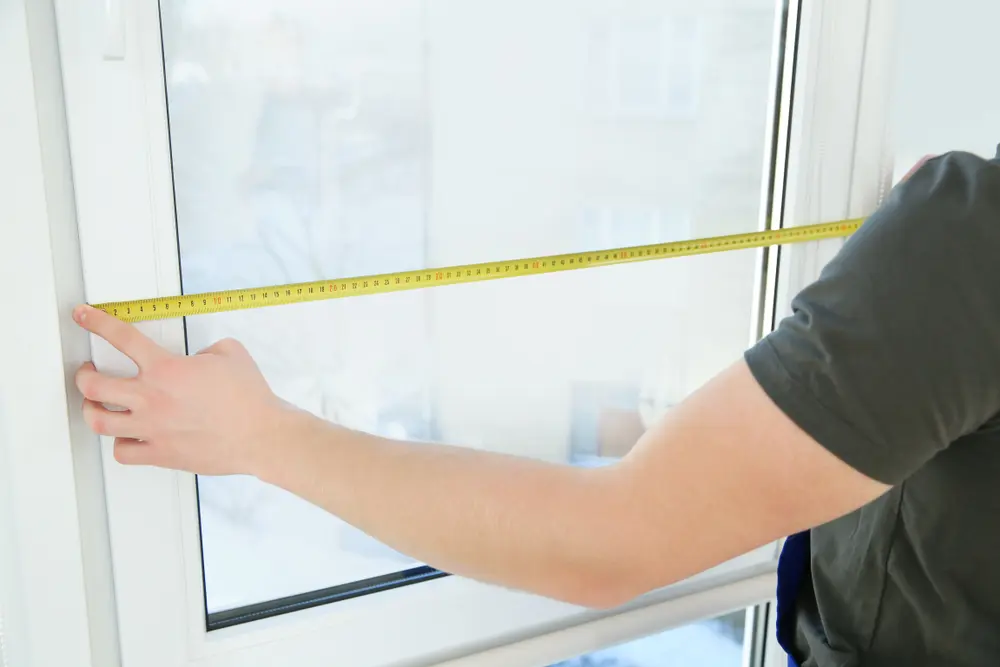The right blinds can completely transform the look and functionality of your living space. However, even the most beautiful blinds can fall short if they don’t fit properly. Measuring your window will ensure a seamless custom fit for your new roller blinds, Thermalite shutters, timber blinds or vertical blinds. Blinds 4U will show you how.
Getting Started
Before starting your measurements, ensure you have the right tools. You’ll need a tape measure long enough to span the entire window at once and capable of showing the measurement millimetres. The tape measure should be steel, not fabric, as this will give you a more accurate measurement. Of course, you’ll need a pen and paper to note the measurements. Take time with this process; precise measurements will impact your new blinds’ appearance and functionality. To help you in this regard, measure two or three times – and if someone is close at hand, ask them to measure as well. A second opinion is always helpful! And you MUST measure all windows, even if they appear to be the same size.
Measuring For Inside Mount Blinds
The right blinds can completely transform the look and functionality of your living space. However, even the most beautiful blinds can fall short if they don’t fit properly. Measuring your window will ensure a seamless custom fit for your new roller blinds, Thermalite shutters, timber blinds or vertical blinds. Blinds 4U will show you how.
For inside mount blinds (inside fit) on standard rectangular windows, begin by measuring the width of the window recess. In other words, take measurements from the inside edges of the window frame from side to side. Please remember that in all cases, the width is the first measurement given for the quoting and making of blinds. When measuring the width, take three measurements: at the top, the middle and the bottom. You will use the smallest of these measurements.
Measure the depth of the recess to ensure the blind fits within it. Measure inside the frame from the front to the first obstruction, such as glass, handle, latch, mullion or transom. Mullions are vertical structures that run from frame to frame, top to bottom. On the other hand, transoms are horizontal structures that run from frame to frame or frame to mullion. You want to ensure your blind will run clear of obstructions like these, so this is an important measurement.
To measure the window’s height (drop), start from the frame’s inside edge at the top and go to the inside edge of the bottom frame. Take three measurements from the window’s left, centre and right and record the smallest measurement as the drop.
Please note that the width you are measuring with roller blinds will be from bracket to bracket, with the fabric being approximately 30 to 35 millimetres smaller.
Measuring For Outside Mount Blinds
It might be more practical to measure outside mount blinds. For example, if the window frame cannot hold the blind inside the recess without hitting an obstruction such as handles or latches. While outside mount blinds might not be as sleek as their inside-fit counterparts, they do provide a high degree of privacy.
Do an outside fit check for outside mount blinds to ensure enough wall space on either side of the blind. The blind should overlap either side of the architrave by at least 100mm. Again, start by measuring width; unlike inside mount blinds, only one measurement is required. The blind can be fitted above or onto the architrave. If there is no architrave, e.g. (the window frame is grooved to take the gib, the blind can only be fitted above the window frame.
When installing above the architrave, decide where you want the top of the blind to be located. You will need the following clearance between the top of the blind and the architrave to fit the brackets.40mm for Vertical blinds, 60mm for Timber & PVC blinds, 30mm for 25mm Venetians and 50mm for roller blinds. Measure the drop to 50mm below the sill architrave for all blinds.
Measuring Not-So-Conventional Windows
Not all windows are perfectly flat and square (or rectangular). Many homes use windows as architectural features in their own right, and they are often three-dimensional– they can be cornered windows, protruding out, or protruding in. Measuring windows of this nature is a little more complicated but not impossible. We have linked to an easy-to-follow diagram-based guide, which will take you through each step in measuring for blinds in corner, box, and 45-degree bay windows. The blend of diagrams and words makes it easier to understand this measuring process.
Common Mistakes To Avoid
At the risk of repeating ourselves, we want to ensure you avoid these mistakes when measuring your windows.
- Don’t use a fabric tape measure; this isn’t as accurate as a steel tape measure.
- Never measure and record height first. Always start with the width and make that the first measurement you send us.
- One measurement from side to side and from top to bottom is needed when measuring for inside mount blinds. Do three measurements horizontally, then three vertically and record the smallest measurement.
- Do not assume all windows are the same size, even if they look similar. Measure each one.
- Please make sure to double-check your measurements. Take the time to do it two or three times if required.
Blinds4U Is Here To Help
Choosing the right blinds always starts with measuring your windows correctly, and we are here to help if you need us. Visit our website for advice and to check out the fantastic blinds that will soon be a beautiful feature in your home.

